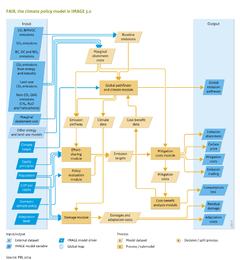Climate policy/Policy issues: Difference between revisions
Jump to navigation
Jump to search
No edit summary |
No edit summary |
||
| Line 6: | Line 6: | ||
The policy evaluation module was used for determining the emission reductions resulting from the pledges made for 2020 ([[Den Elzen et al., 2012b]]). Here, as an example, the results for Brazil are presented (see Figure above). In 2011, Brazil provided a new, higher estimate for its business-as-usual emissions, against which its 36% to 39% reduction pledge is to be applied. The total pledge for all greenhouse gas emissions (including emissions from deforestation) lead to reductions of 20% to 24% according to the [[PBL]]/[[IIASA]] [[BAU]] emission projections. | The policy evaluation module was used for determining the emission reductions resulting from the pledges made for 2020 ([[Den Elzen et al., 2012b]]). Here, as an example, the results for Brazil are presented (see Figure above). In 2011, Brazil provided a new, higher estimate for its business-as-usual emissions, against which its 36% to 39% reduction pledge is to be applied. The total pledge for all greenhouse gas emissions (including emissions from deforestation) lead to reductions of 20% to 24% according to the [[PBL]]/[[IIASA]] [[BAU]] emission projections. | ||
These reductions are substantially lower than those pledged from national BAU projections by Brazil (see Figure above, left-hand graph). This figure also shows that all reductions result from reduced emissions from deforestation. The contributions from REDD projects (about 560 MtCO2) are expected to exceed or match the required total reduction in all greenhouse gases of 470 and 570 MtCO2 eq for the unconditional minimum (low: 36%) and maximum (high: 39%) pledge scenarios. | These reductions are substantially lower than those pledged from national BAU projections by Brazil (see Figure above, left-hand graph). This figure also shows that all reductions result from reduced emissions from deforestation. The contributions from [[REDD]] projects (about 560 MtCO2) are expected to exceed or match the required total reduction in all greenhouse gases of 470 and 570 MtCO2 eq for the unconditional minimum (low: 36%) and maximum (high: 39%) pledge scenarios. | ||
Revision as of 13:47, 17 December 2013
Parts of Climate policy/Policy issues
